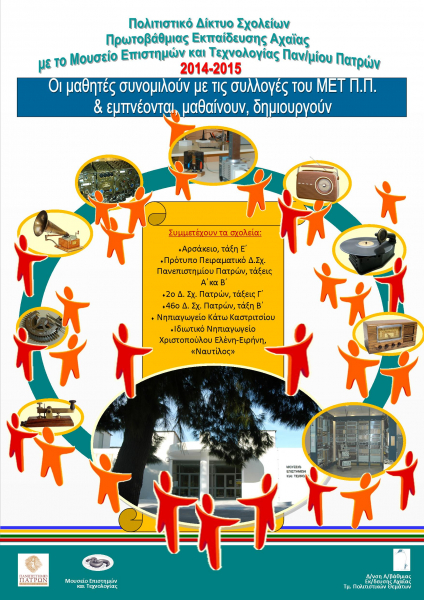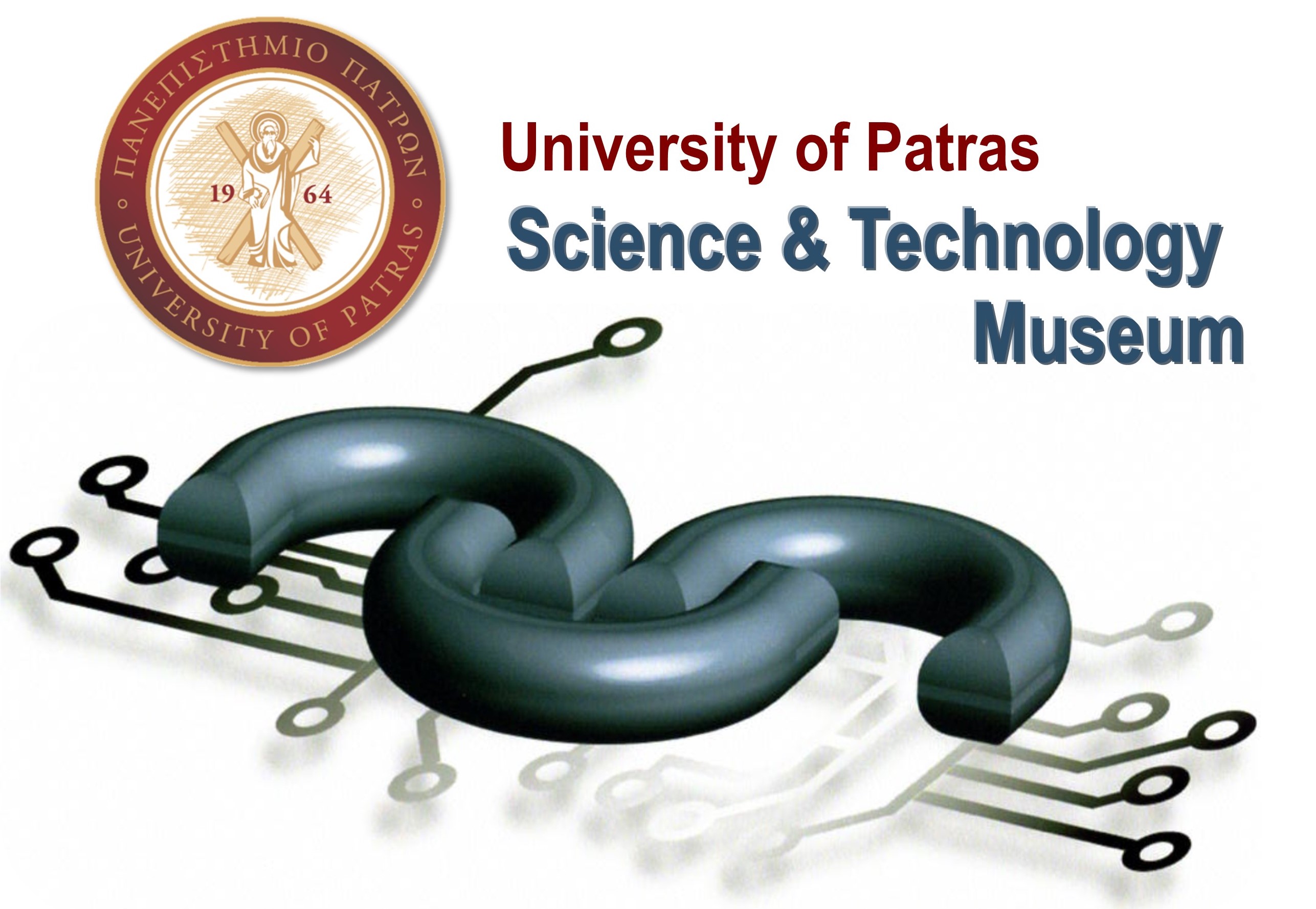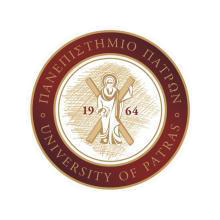- Home
- Activities
- Thematic Networks
- Cultural Network “The students converse with the collections of the UP STM & are inspired, are learning and are creating”
Thematic Networks
- Home
- Activities
- Thematic Networks
- Cultural Network “The students converse with the collections of the UP STM & are inspired, are learning and are creating”
Cultural Network “The students converse with the collections of the UP STM & are inspired, are learning and are creating”

Science & Technology Museum, University of Patras Campus, Greece
The Thematic Cultural Network “The students converse with the collections of the UP STM & are inspired, are learning and are creating” is organized by the Department of Cultural Affairs of Primary Education of Achaia and the Science and Technology Museum. Its general goal is for students to understand the role of the museum as a space in which documents of human culture and environment are collected, studied, preserved, and exhibited with the aim of studying, educating, entertaining (International Council of Museums), passing from the personal experience of the collection to the collective need for a Museum in general and for the need to exist a Science and Technology Museum.
Suggested activities:
- Investigation of students' knowledge:
The question is asked, “What comes to mind when you hear the word museum?” or “What does a museum contain in your opinion?” and then 'What is and what can a Science and Technology Museum contain?'
- The answers are recorded, indexed and determine the composition of the groups, the subthemes and the goal setting.
- We ask the students to talk to us about how they preserve their family memories (photos, mementos, souvenirs from trips, etc.)
- We discuss why we all do such a thing (memories, family traditions, relics, and fairy tales: tradition from one generation to another 'evidence' of another era)
- We conclude on how this is done on a social level, ending up in museums
- From now and beyond we specialize in the museum that we will deal with, in this case, the Science and Technology Museum of the University of Patras and in our preparation before the visit, in our actions during the visit, and in the composition of our experience after the visit.
INSTRUCTIONS FOR THE TEACHER IN THE CLASSROOM
Activities before the visit to the Science and Technology Museum of the University of Patras
General objectives
1. Children to understand the usefulness of a technological museum.
2. To recognize its value.
3. To love it.
4. To integrate it substantially into their daily lives as a source of knowledge, a process of learning and entertainment.
Specific objectives
1. To come into contact with different kinds of science and technology museums.
2. To discover the most important similar museums in Greece and in the world.
3. To locate the functions of this museum.
4. To distinguish the occupations of workers in such a museum.
5. To build the concept of a “science and technology museum”.
6. Discover acceptable and unacceptable behaviors in a museum.
7. To get in touch with the learning processes in a museum.
8. To link learning to visiting a museum.
9. Evaluate their visit.
10. Choose the museum as a place of learning and entertainment.
The visit to the museum should be preceded by a multifaceted preparation for the students. Indicatively, there are activities from which we can choose to be the most suitable for the age and level of the students.
- We listen to, dramatize and color the song “In the museum”, from the cd “Here Lilipoupoli”.
- We etymologically explore the word museum, referring to definitions from printed or digital dictionaries and from related books (e.g. Museums and Schools, Dinosaurs and Vases, Alkistis Kontogianni, Ed. Greek Letters, Athens, 1995, p. 16 “What is a museum”).
- We supplement the search with the appropriate investigation of the words “science, technology”.
- We make families of words with the same root (muse, music, museum, science, technology) per group and each group utilizes them by creating a small, perhaps surreal, or humorous story.
- We ask with a barrage of ideas to mention types of museums. We process worksheets with ciphers to generate other types of museums. We discuss and categorize. With the names of the resulting museums (Byzantine, archaeological, folklore, science and technology), we write sentences to which students attribute the incredible uses of the museum.
- We are looking for information about great museums in Greece and in the world.
- Each group presents to the class a museum of science and technology national or international that they will choose.
- We give opportunities to students from other countries to present a museum of their own.
- We make reference dashboards that we enrich.
- We discuss how we end up in a museum (Procedures for research, collection, conservation, documentation, exhibition)
- In order to involve them in a similar process, we ask that each one of them bring an object e.g. mobile phone, old landline phone, old radio, etc. of folk art, we investigate it, we document its origin, use, construction, we photograph it, we exhibit it in our classroom)
- We give the map of the city and ask each group to map the route from the school to the UP STM. Patras museum, from their houses to the museum, from the school to the museum.
- We make a historical timeline and place it on top of the museums of the city to demonstrate the latest of the creation of the Science and Technology Museum.
- We ask the teams to plan how they would arrange a visit to a museum by calling the responsible employee of the museum. We assign someone, and after they have arranged it and written it, we ask to represent it as a theatrical event, (one member of the group calls and says what the group agreed and another member plays the responsible employee). We reward the team that admittedly did better by actually arranging the visit.
- We assign students to write questionnaires for the museum's officers. (We record the conversations or simply note the responses during the visit).
- We cultivate the appropriate behavior within a museum
- We read the excerpt “The museum of painting”, from the book “Little Nicholas has fun”, R. Goscinny, JJ Sempe, p. 89-95, and we discuss what went wrong and why.
- For younger students suitable would be “Little Hermes” by Eugene Trivizas or “At the museum” by Marisa de Castro
- We assign per group telephone games or theatrical events or puppetry (use cheap materials: newspapers, old socks, paper bags) with topics aimed at cultivating good behavior in the museum e.g. “Two statues of radios discuss their adventures”, “A telephone vase confesses its sufferings”, “The museum keeper complains to his mom”, “The mice that live in the museum discuss about the good and noisy visitors”... Etc.
- We play “frozen images”, asking the students to represent the exhibit, the visitor who observes it, someone who makes an obstruction because of the position he has taken, the attitude of the guard, the guide, the animator, the assistant, the archaeologist, the scientist, what happens if someone goes to touch an exhibit, so that we can define how we stand, where, and how we observe.
- We assign the teams to make two instruction boards with what we can and cannot do at the museum we are going to visit.
- We stimulate the imagination before the visit by assigning the children with fantasy exercises, to write and dramatize or design a comic on topics such as:
o In the evenings, when the museum closes the objects come alive. What is going on? What do they talk about? Where do they go? Who do they meet?
o Two neighboring exhibits discuss about...
During the visit
We are attending and observing an educational program at the STM.
We choose to see up close the objects proposed by the Network and we select with the students one of them to develop our own educational activity.
ITEMS TO CHOOSE FROM:
PYRSIA, TELEPHONE WITH A CRANK, TELEPHONE CENTER, RADIO, RECORD PLAYER, TAPE RECORDER, GRAMOPHONE, MORSE TELEGRAPH, TELEX, MANUAL SWITCHBOARD, THE FIRST MODEM
Activities after the visit
After the students choose one of the subjects suggested during their visit to the STM, and after their return to their classroom, they should:
- study its technological course, its relationship with science, and the social needs that dictated its creation and transformation.
- represent it visually. Imagine it telling its story.
- describe the change of the object in the future, as the students imagine it.
- develop educational activities around the selected subject and propose one, which will be presented by the students in the final presentation of the network on world museum day.
Also:
- discuss, comment, and compose experiences from the visit.
- make a collage with museums of Science and Technology of the world.
- make a poster for the Museum
- write a thank you letter to the Museum
or
- We ask the museum to “evaluate” us as visitors, by developing an evaluation form of our own (what kind of visitors have we been? Quiet? Prepared? Methodical? How did we stand in front of the exhibits? Did we ask pertinent questions to the museum staff? Did we respect the place and time of the visit? etc.) or by asking them to complete the one they may have.
List of Dates (Page event details)
- From 30 November 2014 to 31 May 2015
Powered by iCagenda
One Object Every Month
Announcements
Calendar
| Mon | Tue | Wed | Thu | Fri | Sat | Sun |
|---|---|---|---|---|---|---|
STM's Events
STM's Newsletter
Popular Articles
- Museum Water Kits
- Permanent exhibition "Telecommunications in our lives"
- The Science and Technology Museum at the Development Forum Network 2023 “University of Patras, Science and Technology Museum: Interacting with Society”
- Awarding schools in the Local Photography Competition “Capturing the water systems of my country”.
- The Second Digital Exhibition of Virtual Reality (VR) of the Science and Technology Museum is a fact!!!














